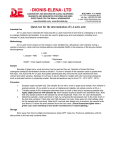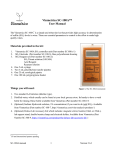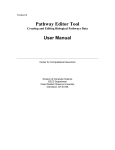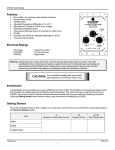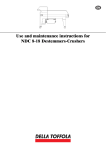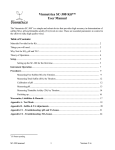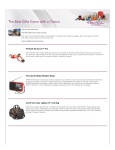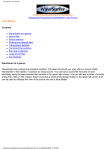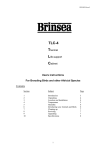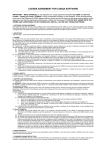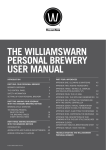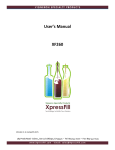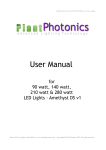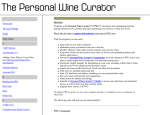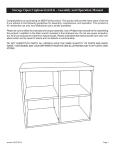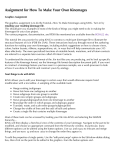Download User manual.
Transcript
Intended Use AV-Free SO2 is intended for measuring the level of unbound Sulfur Dioxide in wine, grape juice and must. Methodology AV-Free SO2 is based on the reduction in color exhibited by a dye when it reacts with sulfur dioxide. SO2 (as SO3-2) + dye (colored) SO 3-2 – dye complex (colorless) Sample Samples of wine and must should be used as is. The ACCUVIN AV-Free SO2 test minimizes the usual interferences from colored and turbid samples. Samples do not have to be pre-filtered or treated with color removing substances such as activated carbon or polyamide powder. Sample temperature may be from 0°C - 35°C (32°F - 95°F). Procedure Note: The ACCUVIN AV-Free SO2 test covers two ranges. A high range test (tubes with red caps) covers the range of 40 – 130 ppm, and is usually applicable for sweet wines and for wines with a pH of 3.7 or higher. The low range test (tubes with green caps) covers the range 0 – 40 ppm, and is usually applicable for wines with a pH of 3.6 or less. 1. 2. 3. Squeeze upper sampler bulb. Dip sampler tip into grape juice, must or wine sample, then slowly release bulb to aspirate sample. Wipe sampler tip to remove excess droplets. (If you prefer to use an air displacement pipette, set sample volume at 53 L.) Open sample tube. Transfer sample to test tube by placing sampler tip into the test reagent and squeezing sample bulb only once. Withdraw sampler prior to releasing sampler bulb. Note that only sample present in the sampler tip will be dispensed. Replace sample tube cap. Shake tube. Wait 5 min. for color development. Determine sample Free SO2 level in ppm by comparing the developed color to the color chart on the test strip container. Read tube color by holding tube about 1 inch (2.5 cm.) above a white background. If test strip color falls between two color chips select an intermediate value for the sample Free SO2 level. (Since fluorescent lights have a green cast, color matching is best under incandescent or natural lighting.) Storage Store away from direct sunlight at temperatures below 80ºF. Product is satisfactory until the date printed on the test tube container label. Interpretation Sulfur dioxide is a chemical not normally present in grapes, but when present it can have a powerful antibacterial effect. One source of sulfur dioxide in musts is from yeasts during alcoholic fermentation. Although not a prevalent problem, the levels produced in this manner may be sufficient to cause inhibition of malolactic bacteria. These levels are dependent on the yeast strain, the availability of nutrients, and the presence of compounds in the must to which sulfur dioxide binds. A more common source of sulfur dioxide in musts and wines is through addition by the winemaker. These additions are made for the following reasons: · At crush/destemming to inhibit native bacteria, especially lactic acid bacteria, which could cause formation of undesirable compounds such as acetic acid. · At crush/destemming to inhibit browning, especially in white grapes · After alcoholic fermentation to inhibit lactic acid bacteria and reduce the likelihood of unplanned malolactic fermentation by malolactic organisms. · During aging and just prior to bottling to reduce enzymatic and chemical oxidation and control bacteria. The total amount of sulfur dioxide present in must and wine is not all useful as a preservative. Some is bound to other chemical components, reducing its effectiveness as a preservative by 30 – 70%. Also, the degree of binding can change over time, affecting the ability of an adequate dose to continue providing its preservative properties. The effectiveness of sulfur dioxide as a preservative is also pH-dependent, with low pH wines requiring lower levels, and high pH wines requiring significantly greater concentrations to achieve the same effectiveness as in a typical wine with a pH of 3.3 - 3.4. Summary Interpretation for Most Wines (Because of varietal & stylistic differences, growers & winemakers should make final interpretations.) Interpretation for wines at pH 3.3 – 3.5 Level to control harmful microorganisms in fresh musts for red wine from Free SO2 20 30 ppm 3 0 7 0 20 – 5 0 100 4 0 clean, sound fruit pre-fermentation w/o inhibiting MLF 4 Level to control browning in white musts, harmful microorganisms in fresh ppm ppm juice from clean, sound fruit 3 Level to control browning in white musts, harmful microorganisms in fresh juice ppm from fruit showing evidence of spoilage or rot 3,4 Level desired for bottling 2 Application Table pH % molecular SO2 2.9 3.0 3.1 3.2 3.3 3.4 3.5 3.6 3.7 3.8 3.9 4.0 7.5 6.1 4.9 3.9 3.1 2.5 2.0 1.6 1.3 1.0 0.8 0.7 free SO2 needed to achieve molecular SO2 of: 0.5 ppm 0.8 ppm 2.0 ppm* 7 11 27 8 13 33 10 16 41 13 21 51 16 26 64 20 32 80 25 40 100 31 50 125 39 63 157 49 79 197 62 99 248 78 125 312


